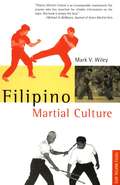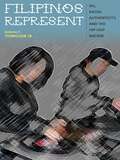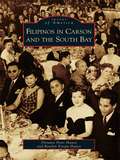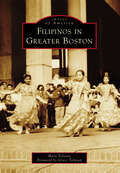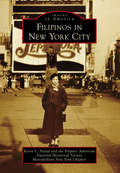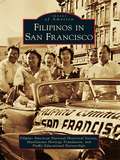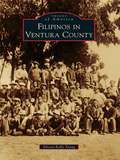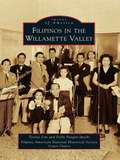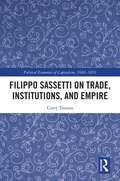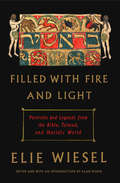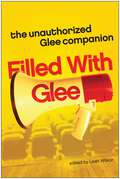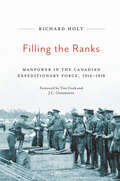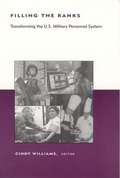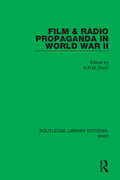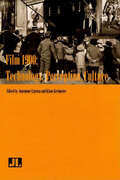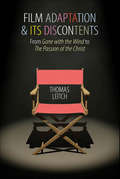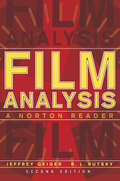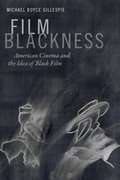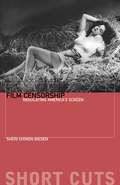- Table View
- List View
Filipino Martial Culture
by Mark V. WileyA classic reference for martial artists and aficionados of Filipino culture, Filipino Martial Culture is an unprecedented excursion into the history, ideology, and techniques of Filipino martial arts. Beginning with a comprehensive study of the history of civil turbulence in the Philippines and the participation of its warriors in fights for independence from colonial rulers, Filipino Martial Culture proceeds to explore the worldview, spirituality, folklore and weaponry of this ancient tradition.Mark Wiley has collected extensive interviews with Filipino martial arts masters, as well as photographs of their practice and weaponry, in his preparations for this book. He explains basic and rare techniques, elucidating the ethos of much of Filipino culture in the process. The authority and depth of his materials are unsurpassed; Filipino Martial Culture is as much a definitive anthropological textbook as it is a practical guide to the martial arts
Filipino Martial Culture
by Mark V. WileyA classic reference for martial artists and aficionados of Filipino culture, Filipino Martial Culture is an unprecedented excursion into the history, ideology, and techniques of Filipino martial arts. Beginning with a comprehensive study of the history of civil turbulence in the Philippines and the participation of its warriors in fights for independence from colonial rulers, Filipino Martial Culture proceeds to explore the worldview, spirituality, folklore and weaponry of this ancient tradition.Mark Wiley has collected extensive interviews with Filipino martial arts masters, as well as photographs of their practice and weaponry, in his preparations for this book. He explains basic and rare techniques, elucidating the ethos of much of Filipino culture in the process. The authority and depth of his materials are unsurpassed; Filipino Martial Culture is as much a definitive anthropological textbook as it is a practical guide to the martial arts
Filipino Martial Culture
by Mark V. WileyWidely practiced but not always understood, the Filipino martial arts have a rich history and distinctive character that until now have not fully been documented. Written in the context of Philippine history and culture, Filipino Martial Culture uncovers the esoteric components of the Filipino martial arts and the life histories of the men who perpetuate them. Included are: the history of turbulence and war in the Philippines from prehistoric times to the present day; the culture of the Filipino martial arts, including warrior ethos and worldview, spirituality, folklore, and weaponry; biographical sketches of eighteen Filipino masters and descriptions of their respective fighting styles; and a comparative study of the ethos, ideology, and development of the Filipino martial arts in relation to the considerable martial traditions of India, China, and Japan.In the course of his research, internationally renowned martial arts master and scholar Mark V. Wiley traveled the globe, interviewing top masters and recording their life histories, thoughts, and anecdotes. In addition, he collected 320 historical photographs and illustrations, including step-by-step sequences of the masters demonstrating the distinctive techniques of their particular martial styles. Filipino Martial Culture is a classic reference for practitioners and researchers alike!
Filipinos Represent: DJs, Racial Authenticity, and the Hip-hop Nation
by Antonio T. Tiongson Jr.The &“Hip-hop Nation&” has been scouted, staked out, and settled by journalists and scholars alike. Antonio T. Tiongson Jr. steps into this well-mapped territory with questions aimed at interrogating how nation is conceptualized within the context of hip-hop. What happens, Tiongson asks, to notions of authenticity based on hip-hop&’s apparent blackness when Filipino youth make hip-hop their own? Tiongson draws on interviews with Bay Area–based Filipino American DJs to explore the authenticating strategies they rely on to carve out a niche within DJ culture. He shows how Filipino American youth involvement in DJing reconfigures the normal boundaries of Filipinoness predicated on nostalgia and cultural links with an idealized homeland. Filipinos Represent makes the case that while the engagement of Filipino youth with DJ culture speaks to the broadening racial scope of hip-hop—and of what it means to be Filipino—such involvement is also problematic in that it upholds deracialized accounts of hip-hop and renders difference benign. Looking at the ways in which Filipino DJs legitimize their place in an expressive form historically associated with African Americans, Tiongson examines what these complex forms of identification reveal about the contours and trajectory of contemporary U.S. racial formations and discourses in the post–civil rights era.
Filipinos in Carson and the South Bay (Images of America)
by Florante Peter Ibanez Roselyn Estepa IbanezOne of Carson's most distinct features is its diversity. The city is roughly one-quarter each Hispanic, African American, white, and Asian/ Pacific Islander. This last group's vast majority are Filipinos who settled as early as the 1920s as farmworkers, U.S. military recruits, entrepreneurs, medical professionals, and other laborers, filling the economic needs of the Los Angeles region. This vibrant community hosts fiestas like the Festival of Philippine Arts and Culture and has produced local community heroes, including "Uncle Roy" Morales and "Auntie Helen" Summers Brown. Filipino students of the 1970s organized to gain college admissions, establish ethnic studies, and foster civic leadership, while Filipino businesses have flourished in Carson, San Pedro, Wilmington, Long Beach, and the surrounding communities. Carson is recognized nationally as a Filipino American destination for families and businesses, very much connected to the island homeland.
Filipinos in Greater Boston (Images of America)
by Mary TalusanAs early as the Civil War, a dozen Filipino men living in Massachusetts enlisted in the Union army. In the 1900s, Filipino pensionados studied at Harvard, the Massachusetts Institute of Technology, and other colleges. After the Immigration and Nationality Act of 1965, Filipino medical, military, and other professionals settled in and around Greater Boston in Cambridge, Lexington, Malden, and Quincy. To support their communities, Filipino immigrants founded civic organizations such as the Philippine Medical Association of New England, Pilipino-American Association of New England, and Philippine Nurses Association of New England. Since 1976, parents have been volunteering at Iskwelahang Pilipino (Filipino school) to encourage their American-born children's pride for Filipino traditions. Included are never before seen photographs of the Aquino family during their time in exile. This book highlights the rich histories of Filipinos in Greater Boston and aims to inspire more works that document our immigrant community that has grown in the early 21st century to over 25,000 people.
Filipinos in New York City
by Kevin L. Nadal Filipino-American National Historical SocietyAfter the Spanish-American War in 1898, many Filipinos immigrated to New York City, mostly as students, enrolling at local institutions like Columbia University and New York University. Some arrived via Ellis Island as early as 1915, while Filipino military servicemen and Navy seafarers settled in New York after both World Wars I and II. After the Asian Immigration Act of 1965, many Filipinos came as professionals (e.g., nurses, physicians, and engineers) and formed settlements in various ethnic enclaves throughout the five boroughs of New York. Over the years, Filipinos have contributed significantly to New York arts and culture through Broadway theater, fashion, music, film, comedy, hip-hop, poetry, and dance. Filipino New Yorkers have also been successful entrepreneurs, corporate executives, community leaders, and politicians, and some, sadly, were victims of the 9/11 World Trade Center attacks.
Filipinos in San Francisco (Images of America)
by Pin@y Educational Partnerships Filipino American National Historical Society Manilatown Heritage FoundationTens of thousands of Filipinos who have lived, worked, and raised families for over five generations in this unique city stake their rightful claim to more than a century of shared history in San Francisco. The photographs herein attest to the early arrivals, who came as merchant mariners, businesspeople, scholars, and musicians, as well as agricultural and domestic workers. But their story has often been ignored, told incompletely by others, and edited too selectively by many. The Filipino American experience both epitomizes and defies the traditional immigrant storyline, and these pictures honestly and respectfully document the fruits of their labors, the products of their perseverance, and, at times, their resistance to social exclusion and economic suppression.
Filipinos in Vallejo (Images of America)
by Mel OrpillaFilipinos came to Vallejo as early as 1912, and some families here can count five generations back to their roots in the Philippines. Many came to Mare Island Naval Shipyard, where Filipinos found steady, well-paying jobs that spared them from menial work and stoop labor in the fields of California. With each major conflict of the 20th century, and finally with the relaxation of immigration quotas in 1965, waves of Filipino newcomers arrived on these shores. They advanced in their work at the shipyards, settled down, and started families, buying homes and establishing successful businesses. Now this active, politically empowered Filipino community numbers in the tens of thousands, yet traditional histories ignore its contribution to Vallejo's heritage.
Filipinos in Ventura County
by Elnora Kelly TayagFilipino immigrants came to Ventura County in the 1920s, beginning American lives mostly as farm laborers in work camps, notably the Arneill Ranch and Springville Ranch in Camarillo. They organized early societies like the Filipino Brotherhood Association of Ventura County, the Jordan Lodge 604 Legionarios del Trabajo, the Caballeros de Dimas Alang, the Filipino Optimist Club, and the Filipino Community of Ventura County. During World War II, Filipinos served in the 1st and 2nd Filipino Infantry Regiments of the U.S. Army. The omnipresence of the U.S. Navy in coastal Ventura prodded many second- and third-generation Filipinos to serve their country in Korea, Vietnam, Desert Storm, and the Persian Gulf. Today the same spirit of community engagement is illustrated in the 26 local Filipino organizations all under the umbrella of the Filipino American Council, which celebrates history, community, and culture.
Filipinos in the Willamette Valley
by Dolly Pangan-Specht Tyrone Lim Filipino American National Historical Society - Oregon ChapterTucked among the great pioneer destinations on the Oregon Trail is the fertile agricultural area of the Willamette Valley. Today the valley forms the cultural and political heart of Oregon and is home to three-quarters of the state's population. The beginning of the 20th century saw the entrance of Filipinos into the valley, arriving from vegetable farms in California and Washington, fish canneries in Alaska, and from the pineapple and sugar plantations in Hawaii. At the same time, the U.S. territorial government in the Philippines started sponsoring Filipino students, beginning in 1903, to study in the United States. Oregon's two biggest centers of education, today's University of Oregon in Eugene and Oregon State University in Corvallis, became home to Filipinos from the emerging independent Philippine nation. They were mostly male, the children of wealthy Filipinos who had connections. Most of them returned to the Philippines upon graduation; some stayed and created a new life in America.
Filippo Sassetti on Trade, Institutions and Empire (Political Economies of Capitalism, 1600-1850)
by Corey TazzaraThe Florentine traveler, merchant, and academician Filippo Sassetti was one of the premier economic thinkers of the late Renaissance. Well known for his ethnographic observations, Sassetti was also a commercial writer of the highest caliber—at once an original thinker and a remarkable witness to how Europeans even at the margins of empire were beginning to reconceptualize power and wealth. Unique among commercial theorists of the period, Sassetti offers a first-hand perspective on commerce in both the Mediterranean and the Indian Ocean. This volume translates (for the first time) the Discourse on Mediterranean Trade and a selection of the principal Indian Letters, with extensive historical notes. These are preceded by a lengthy essay positioning Sassetti as a figure in late Renaissance political economy. It makes the case that Sassetti was an early theorist of what might be termed the pragmatic tradition of free trade—in his case, a project linked to his analysis of commercial institutions in the Mediterranean and the Indian Ocean. Provoking an invaluable overview of trade in the Indian Ocean in the late sixteenth century, this volume is an excellent specialist text for postgraduate students and professional historians.
Filled with Fire and Light: Portraits and Legends from the Bible, Talmud, and Hasidic World
by Elie WieselHere are magnificent insights into the lives of biblical prophets and kings, talmudic sages, and Hasidic rabbis from the internationally acclaimed writer, Nobel laureate, and one of the world&’s most honored and beloved teachers. From a multitude of sources, Elie Wiesel culls facts, legends, and anecdotes to give us fascinating portraits of notable figures throughout Jewish history. Here is the prophet Elisha, wonder-worker and adviser to kings, whose compassion for those in need is matched only by his fiery temper. Here is the renowned scholar Rabbi Yohanan ben Zakkai, whose ingenuity in escaping from a besieged Jerusalem on the eve of its destruction by Roman legions in 70 CE laid the foundation for the rabbinic teachings and commentaries that revolutionized the practice and study of Judaism and have sustained the Jewish people for two thousand years of ongoing exile. And here is Rabbi Shneur Zalman of Liadi, founder of Chabad Hasidism, languishing in a Czarist prison in 1798, the victim of a false accusation, engaging in theological discussions with his jailers that would form the basis for Chabad&’s legendary method of engagement with the world at large. In recounting the life stories of these and other spiritual masters, in delving into the struggles of human beings trying to create meaningful lives touched with sparks of the divine, Wiesel challenges and inspires us all to find purpose and transcendence in our own lives.
Filled with Glee: The Unauthorized Glee Companion
by Leah WilsonIs Sue is the true driving force behind Glee? Who is the real alpha male in New Directions? Why do we really keep coming back to Glee week after week? From its quirky character insights to its inspirational, funny, and touching stories from fellow gleeks, Filled with Glee is the perfect companion for the fan who can't get enough Glee. Other standout sections include: A guide to putting together a glee club in your own school or community An index of Glee song and musical references, by episode Biographies of main and guest actors' musical theater backgrounds (and where and when they've worked together before)
Filling the Ranks: Manpower in the Canadian Expeditionary Force, 1914-1918
by J. L. Granatstein Tim Cook Richard HoltManpower is the lifeblood of armies regardless of time or place. In the First World War, much of Canada’s military effort went toward sustaining the Canadian Expeditionary Force, especially in France and Belgium. The job was not easy. The government and Department of Militia and Defence were tasked with recruiting and training hundreds of thousands of men, shipping them to England, and creating organizations on the continent meant to forward these men to their units. The first book to explore the issue of manpower in the Canadian Expeditionary Force, Filling the Ranks examines the administrative and organizational changes that fostered efficiency and sustained the army. Richard Holt describes national civilian and military recruitment policies and criteria both inside and outside of Canada; efforts to recruit women, convicts, and members of First Nations, African Canadian, Asian, and Slavic communities; the conduct of entry-level training; and the development of a coherent reinforcement structure. Canada’s ability to fill the ranks with trained soldiers ultimately helped make the Corps an elite formation within the British Expeditionary Force. Based on extensive research in British and Canadian archives, Filling the Ranks provides a wealth of new information on Canada"s role in the Great War.
Filling the Ranks: Manpower in the Canadian Expeditionary Force, 1914-1918 (Carleton Library Series)
by Richard HoltManpower is the lifeblood of armies regardless of time or place. In the First World War, much of Canada’s military effort went toward sustaining the Canadian Expeditionary Force, especially in France and Belgium. The job was not easy. The government and Department of Militia and Defence were tasked with recruiting and training hundreds of thousands of men, shipping them to England, and creating organizations on the continent meant to forward these men to their units. The first book to explore the issue of manpower in the Canadian Expeditionary Force, Filling the Ranks examines the administrative and organizational changes that fostered efficiency and sustained the army. Richard Holt describes national civilian and military recruitment policies and criteria both inside and outside of Canada; efforts to recruit women, convicts, and members of First Nations, African Canadian, Asian, and Slavic communities; the conduct of entry-level training; and the development of a coherent reinforcement structure. Canada’s ability to fill the ranks with trained soldiers ultimately helped make the Corps an elite formation within the British Expeditionary Force. Based on extensive research in British and Canadian archives, Filling the Ranks provides a wealth of new information on Canada"s role in the Great War.
Filling the Ranks: Transforming the U.S. Military Personnel System
by Cindy WilliamsThe war in Iraq and the problematic military occupation of that country have called into question the adequacy of America's all-volunteer force. Politicians and others have expressed doubts about its equity and capability; some have called for the reinstatement of the draft. Yet over the past twenty years the all-volunteer military has become a technologically advanced force that has contributed to America's overall military advantage. This book analyzes current military pay and personnel policies and identifies changes needed to maintain and improve America's all-volunteer force. Filling the Ranks argues that to attract qualified and motivated volunteers, the armed forces need to offer better tangible inducements -- pay, benefits, and training -- to accompany such intangible rewards as pride in serving one's country. Many of the policies related to tangible rewards were established shortly after World War II and are no longer effective. Filling the Ranks presents detailed assessments of US military pay and personnel policies in light of the strategic, demographic, economic, and labor realities of the future. It identifies specific problems that today's military career patterns, training, pay, and benefits pose for officers and enlisted men and women in both active duty and reserve forces, discussing such issues as competition with the private sector for talent, the need to restructure compensation, and provision of family support. It offers recommendations for more flexible, adaptive, and effective policies and a blueprint for achieving them.
Film & Radio Propaganda in World War II (Routledge Library Editions: WW2 #9)
by K.R.M. ShortThis book, first published in 1983, brings together leading world experts on film and radio propaganda in a study which deals with each of the major powers as well as several under occupation. By examining each nations’ propaganda content and comparing its various strands of output designed for different audiences, the historian is provided with an important source of a nation’s official self-image. Total war forced governments to formulate goals consistent with the received national ideology in order to support the war effort. To this extent, much of the domestic propaganda was directed towards stimulating the population to make sacrifices with promise of a new world if the peace were won.
Film 1900: Technology, Perception, Culture
by Klaus Kreimeier Annemone LigensaThe current digital revolution has sparked a renewed interest in the origins and trajectory of modern media, particularly in the years around 1900 when the technology was rapidly developing. This collection aims to broaden our understanding of early cinema as a significant innovation in media history. Joining traditional scholarship with fresh insights from a variety of disciplines, this book explains the aesthetic and institutional characteristics in early cinema within the context of the contemporary media landscape. It also addresses transcultural developments such as scientific revolutions, industrialization, urbanization, and globalization, as well as differing attitudes toward modernization. Film 1900 is an important reassessment of early cinema's position in cultural history.
Film Adaptation and Its Discontents: From Gone with the Wind to The Passion of the Christ
by Thomas LeitchMost books on film adaptation—the relation between films and their literary sources—focus on a series of close one-to-one comparisons between specific films and canonical novels. This volume identifies and investigates a far wider array of problems posed by the process of adaptation. Beginning with an examination of why adaptation study has so often supported the institution of literature rather than fostering the practice of literacy, Thomas Leitch considers how the creators of short silent films attempted to give them the weight of literature, what sorts of fidelity are possible in an adaptation of sacred scripture, what it means for an adaptation to pose as an introduction to, rather than a transcription of, a literary classic, and why and how some films have sought impossibly close fidelity to their sources. After examining the surprisingly divergent fidelity claims made by three different kinds of canonical adaptations, Leitch's analysis moves beyond literary sources to consider why a small number of adapters have risen to the status of auteurs and how illustrated books, comic strips, video games, and true stories have been adapted to the screen. The range of films studied, from silent Shakespeare to Sherlock Holmes to The Lord of the Rings, is as broad as the problems that come under review.
Film After Film
by J. HobermanOne of the world's most erudite and entertaining film critics on the state of cinema in the post-digital--and post-9/11--age. This witty and allusive book, in the style of classic film theorists/critics like André Bazin and Siegfried Kracauer, includes considerations of global cinema's most important figures and films, from Lars von Trier and Zia Jiangke to WALL-E, Avatar and Inception.
Film Analysis: A Norton Reader
by Jeffrey Geiger R. L. RutskyContributors examine American, European, and international films as artifacts of their times, as indicators of changes and innovations in ways of thinking about and approaching reality, and as influences upon each other and on the viewer.
Film Analysis: A Norton Reader (Second Edition)
by Jeffrey Geiger R. L. RutskyFifty essays on fifty films—by a who’s-who of film studies. Film Analysis offers concise analyses of fifty diverse and historically significant films—each written exclusively for the text by a leading scholar. Written with the undergraduate in mind, the essays are clear, readable, and great models for students to follow in helping them to hone their own writing. The Second Edition includes six new essays, a new, detailed guide to writing film analysis, and an extensive, up-to-date glossary of critical film terms. This purchase offers access to the digital ebook only.
Film Blackness: American Cinema and the Idea of Black Film
by Michael Boyce GillespieIn Film Blackness Michael Boyce Gillespie shifts the ways we think about black film, treating it not as a category, a genre, or strictly a representation of the black experience but as a visual negotiation between film as art and the discursivity of race. Gillespie challenges expectations that black film can or should represent the reality of black life or provide answers to social problems. Instead, he frames black film alongside literature, music, art, photography, and new media, treating it as an interdisciplinary form that enacts black visual and expressive culture. Gillespie discusses the racial grotesque in Ralph Bakshi's Coonskin (1975), black performativity in Wendell B. Harris Jr.'s Chameleon Street (1989), blackness and noir in Bill Duke's Deep Cover (1992), and how place and desire impact blackness in Barry Jenkins's Medicine for Melancholy (2008). Considering how each film represents a distinct conception of the relationship between race and cinema, Gillespie recasts the idea of black film and poses new paradigms for genre, narrative, aesthetics, historiography, and intertextuality.
Film Censorship: Regulating America's Screen (Short Cuts)
by Sheri Chinen BiesenFilm Censorship is a concise overview of Hollywood censorship and efforts to regulate American films. It provides a lean introductory survey of U.S. cinema censorship from the pre-Code years and classic studio system Golden Age—in which film censorship thrived—to contemporary Hollywood. From the earliest days of cinema, movies faced controversy over screen images and threats of censorship. This volume draws extensively on primary research from motion picture archives to unveil the fascinating behind-the-scenes history of cinema censorship and explore how Hollywood responded to censorial constraints on screen content in a changing American cultural and industrial landscape.This primer on American film censorship considers the historical evolution of motion-picture censorship in the United States spanning the Jazz Age Prohibition era, lobbying by religious groups against Hollywood, industry self-censorship for the Hays Office, federal propaganda efforts during wartime, easing of regulation in the 1950s and 1960s, the MPAA ratings system, and the legacy of censorship in later years. Case studies include The Outlaw, The Postman Always Rings Twice, Scarface, Double Indemnity, Psycho, Bonnie and Clyde, Midnight Cowboy, and The Exorcist, among many others.
